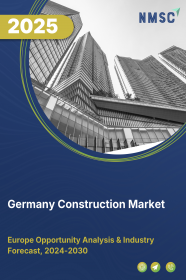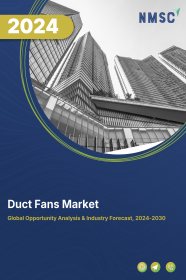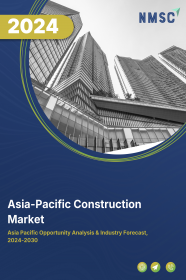
Germany Construction Market by Type (Renovation and New Construction), and by Sector (Real Estate, Infrastructure, and Industrial)–Opportunity Analysis and Industry Forecast, 2024–2030
Industry: Construction & Manufacturing | Publish Date: 19-Feb-2025 | No of Pages: 111 | No. of Tables: 108 | No. of Figures: 43 | Format: PDF | Report Code : CM2198
Germany Construction Market Overview
The Germany Construction Market size was valued at USD 432.80 billion in 2023, and is predicted to reach USD 542.49 billion by 2030, at a CAGR of 4.0% from 2024 to 2030.
The construction market, also known as infrastructure market, is a pivotal contributor to the economy, overseeing the entire spectrum from initial planning to continuous maintenance of diverse physical structures, encompassing infrastructure, buildings, and facilities. This sector encompasses a wide array of projects, spanning residential, commercial, industrial, civil engineering, and institutional infrastructure developments.
It entails collaboration among various stakeholders, including architects, engineers, contractors, suppliers, developers, investors, and government agencies. Positioned for growth, the industry is driven by an increased focus on environmentally sustainable practices such as the integration of green building materials and energy-efficient designs. Furthermore, factors such as rising per capita income in emerging economies and low-interest rates in developed nations are poised to further stimulate the expansion of the infrastructure market.
Government Initiatives Propel Growth in Germany's Infrastructure Sector
The construction market in Germany is currently witnessing a surge in growth driven by the implementation of various government initiatives aimed at constructing new infrastructure projects, particularly railways and power grids. A prominent example of this trend is the USD 49.73 billion infrastructure program recently launched by the German Federal Government and Deutsche Bahn (DB) in September 2023, focusing on the enhancement of the rail network and stations.
This ambitious project aims to significantly enhance the punctuality of train traffic and establish the necessary conditions to achieve transport policy objectives for both passenger and freight traffic. Overall, these government initiatives are anticipated to exert a significant impact on the infrastructure sector in Germany.
Contribution of Infrastructure Sector Fuels Market Expansion in Germany
Furthermore, the expansion of the overall market is propelled by the remarkable growth of the infrastructure sector, that holds a substantial share in the country's GDP. According to the UNECE report, the construction market’s contribution to Germany's GDP was recorded at 5.7% in 2022, surpassing the contributions of other European nations including Denmark, Belgium, and Italy. This significant role of the infrastructure sector in Germany's economy serves as a critical factor driving the market's overall growth.
Regulatory Complexities Impede Growth in the Infrastructure Market
The construction market grapples with significant challenges arising from stringent regulatory frameworks. Infrastructurr ventures face obstacles due to the intricate network of government regulations and permitting processes. Infrastructure projects typically entail securing numerous permits and approvals from governmental bodies at local, regional, and national levels.
These permissions encompass zoning regulations, environmental assessments, compliance with building codes, safety standards, and various regulatory requirements. Lengthy permit acquisition processes, bureaucratic inefficiencies, and regulatory disparities among jurisdictions can significantly prolong project timelines and inflate costs. Additionally, fluctuations in regulations or unexpected policy changes can disrupt ongoing projects and discourage potential investments.
For instance, the United States Environmental Protection Agency (EPA) oversees various aspects of the infrastructure sector, including air quality, lead management, waste disposal, and water regulations. The EPA's compliance assistance centers offer resources to facilitate environmental compliance during demolition activities, the recycling of infrastructure materials, and the proper disposal of refrigeration and air-conditioning equipment.
Integration of Digitalization and BIM Presents Lucrative Opportunity for Market Expansion
The infrastructure sector is undergoing a significant transformation with the integration of digitalization and the adoption of Building Information Modeling (BIM), leveraging advanced technologies to enhance efficiency, accuracy, and collaboration across various projects. BIM, an advanced 3D modeling tool, empowers stakeholders to generate and oversee digital renditions of structures and infrastructure, facilitating improved coordination and communication among project teams.
For example, in September 2022, the National Institute of Building Sciences (NIBS) launched the Germany National Building Information Management (BIM) Program, aiming to revolutionize the infrastructure industry and achieve unprecedented levels of industrial efficiency through digitalization. This initiative addresses the insufficient degree of digitalization within the Germany infrastructure sector, that impedes the evolution of lifecycle work processes to become more efficient, cost-effective, resilient, and safer for infrastructure and maintenance.
Competitive Landscape
The market players operating in the Germany infrastructure industry include Bauer AG, Hochtief AG, Strabag AG, Leonhard Weiss GmbH & Co. KG, Zech Group, Max Bögl Group, Ed. Züblin AG, Bilfinger SE, Vinci SA, Eiffage S.A., ISG Construction, CSE Construction, Althoff Verwaltungsbau GmbH, MMCompact GmbH & MMCompact Reinigung GmbH, Fluor Corporation, and others.
Germany Construction Market Key Segments
By Type
-
Renovation
-
New Construction
By Sector
-
Real Estate
-
Residential
-
Affordable
-
Luxury
-
-
Commercial
-
Retail Buildings
-
Office Buildings
-
Hospitality
-
Healthcare Facilities
-
Educational Institutes
-
Entertainment Ventures
-
-
-
Infrastructure
-
Transportation
-
Airport
-
Port
-
Rail
-
Road
-
-
Water and Wastewater
-
Energy
-
Telecommunication
-
-
Industrial
-
Manufacturing Plant
-
Warehouses
-
Power Plants
-
Oil Refineries
-
Chemical Plants
-
Key players
-
Bauer AG
-
Hochtief AG
-
Strabag AG
-
Leonhard Weiss GmbH & Co. KG
-
Zech Group
-
Max Bögl Group
-
Ed. Züblin AG
-
Bilfinger SE
-
Vinci SA
-
Eiffage S.A.
-
ISG Construction
-
CSE Construction
-
Althoff Verwaltungsbau GmbH
-
MMCompact GmbH & MMCompact Reinigung GmbH
-
Fluor Corporation
REPORT SCOPE AND SEGMENTATION:
|
Parameters |
Details |
|
Market Size in 2023 |
USD 432.80 Billion |
|
Revenue Forecast in 2030 |
USD 542.49 Billion |
|
Growth Rate |
CAGR of 4.0% from 2024 to 2030 |
|
Analysis Period |
2023–2030 |
|
Base Year Considered |
2023 |
|
Forecast Period |
2024–2030 |
|
Market Size Estimation |
Billion (USD) |
|
Growth Factors |
|
|
Companies Profiled |
10 |
|
Market Share |
Available for 10 companies |
|
Customization Scope |
Free customization (equivalent up to 80 working hours of analysts) after purchase. Addition or alteration to country, regional, and segment scope. |
|
Pricing and Purchase Options |
Avail customized purchase options to meet your exact research needs. |

















 Speak to Our Analyst
Speak to Our Analyst

















